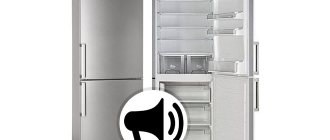Refrigerator location standards
The operating instructions prescribe specific requirements for the location of the refrigeration unit. The unit should not be located adjacent to kitchen furniture. The side gaps must be at least 5 cm, and there must be a distance of at least 10 cm between the back wall and the condenser grille. You can achieve a gap between the floor and the electrical appliance using adjustable legs. The distance is required for constant air circulation. All actions should be aimed at preventing the compressor from overheating.
Is it possible to place a refrigerator next to the battery: at what distance?
At what distance from the battery can a refrigerator be placed? This is a question that often arises in different situations. The design of a modern kitchen and the location of the refrigerator are closely interrelated. You should also take into account the minimum permissible distance from the radiator to the refrigerator. The installation of a far from cheap unit should occupy the most important place in determining the location of kitchen attributes.
Nuances of remoteness
Without thinking whether it is possible to place a refrigerator next to a pipe or radiator and devices for distributing heat, a person places the refrigerator next to them. They may not always heat enough, but they work constantly during the heating season.
A brand new unit, next to which there is a radiator, may not even survive until the end of the warranty period.
Failure to maintain the minimum distance from the rear or side wall will result in poor air circulation along the cooling system location. If we add to this the unit’s system, which in its most advanced design can withstand +43 °C, hot summer time and cooking, you can say goodbye to the desired refrigerator, for which you have been saving money for a long time.
And the last little secret - if the unit is standing at the wrong angle, its door opens with difficulty and does not slam shut spontaneously at the right time, and the open door interferes with movement around a small room - it means that the choice of place is wrong, even if all the previous conditions are met. Warm air will constantly flow into the slightly open refrigerator door, and this is a sure way to damage it, and in a short time.
Before you buy the coveted symbol of kitchen luxury, you need to choose a place where you can put it. There are no hopeless situations, and craftsmen or installers can easily solve the problem with the help of protective devices, sometimes very expensive ones. Are the efforts and resources worth the opportunity to squeeze a refrigerator next to a gas stove or radiator? You need to think carefully. Sometimes it is cheaper to simply purchase a smaller device.
Accommodation conditions and required distance
There must be at least 0.5 meters from the heating appliance to the refrigerator.
The user manual states that the minimum distance from the refrigerator to the battery must be at least 50 cm. This applies not only to heating radiators and piping pipes. A kitchen stove is also considered a heater. During the process of cooking or heating food, it releases a large amount of thermal energy, which spreads to the sides, reflecting from the bottom of the cookware. Because of this, the side walls of the unit heat up. Even if there are no tubes with freon, heat is transferred to the chamber, which causes the relay to operate more frequently, electricity consumption increases and equipment wear accelerates.
Don't forget about the sun. It can heat the refrigerator much more than all household appliances combined. Based on this, you need to place the freezer so that it receives as little sunlight as possible.
When choosing a place to install the refrigerator, you should adhere to the following rules:
- Do not place equipment close to a wall or furniture. You need to use the limiters that the manufacturer puts in the packaging box. Clearance is necessary for the flow of cold air to the radiator and compressor unit.
- Raise the unit as high as possible above the floor. Adjustable legs are used for this. Thanks to this, the ventilation of heating parts will occur more efficiently, and water will not get onto the bottom during wet cleaning in the kitchen or leaks occur.
- If it is not possible to maintain the distance between the refrigerator and the battery recommended by the instructions, you need to use heat-insulating materials. The simplest option is drywall or thin foam. It is even better to use roll or tile insulation made of foamed polyethylene. This is an environmentally friendly material with low thermal conductivity and the absence of harmful emissions when heated.
- Do not place electrical elements of the “warm floor” system in the place where you plan to install the refrigerator. This is equally harmful for both products. They will overheat greatly, which will lead to breakdown and costly repairs.
A radical solution to the problem is to disconnect the battery or insulate it with a heat-insulating material that completely absorbs the released energy. In this case, you will have to solve another question: how to heat the kitchen. It is not difficult to get out of the situation, since modern industry produces many models of compact household heaters of wall, floor and even ceiling types. These are additional costs, but they are much less than regularly purchasing new refrigerators to replace burned out ones.
Distance from battery to refrigerator
Where and at what distance you can place a refrigerator in a limited space is not an easy question and requires a thoughtful approach. Sometimes you can’t do without additional safety measures, even if you plan everything very carefully.
The task set for owners of a kitchen with a small area resembles a puzzle with a labyrinth, where there are prohibitory signs at every corner. After all, the purchased unit cannot be placed in direct sunlight or near heat sources, it cannot be left without the necessary air circulation, but it is also not recommended to place the refrigerator in a draft.
Kitchen in the house
Heating radiators, cooking stoves, other electrical appliances, ovens and hobs - all this is strictly contraindicated in a refrigerator in close proximity. If you can’t at all arrange the pieces of kitchen equipment so as to take into account all the features, you need to try to meet the conditions that allow you to install a battery-powered refrigerator at a small indentation:
- a household electrical appliance cannot be placed on the back wall of the heating device, and the side wall is also not recommended;
- the side wall or door of the refrigeration unit should be at a minimum distance of half a meter, and preferably not in a straight line, but horizontally (in small-sized kitchens of some projects this is possible in the corner near the window, however, in this case the end will be near the pipe, so it must be distanced by distance of at least 30 cm);
- it has been calculated that insufficient distance from the heating radiator, as a result of which the overall air temperature rises by approximately 5–6 °C, increases energy consumption by almost half, so the distance must be observed;
- The distance from the battery can only be reduced with sufficient air circulation or special protective devices.
Refrigerator dimensions
It should be taken into account
Problems with operating a refrigerator in the kitchen of a small apartment arise due to the inability to plan the space or soberly evaluate the purchased equipment. Considerations of prestige or reverence for brand names, as well as the desire to select household appliances based on a single color or design, lead to a common mistake.
This can be easily avoided if you carefully measure the intended installation location and purchase a refrigerator of suitable dimensions.
There are also important points - the class to which the purchase belongs (what temperature it can withstand), the location of the cooling system (it may not be located the same for different manufacturers, as a result of which the installation requirements will differ). These nuances affect the minimum distance from the refrigerator to the heating radiator (battery).
Well-established brands indicate the distance to certain household appliances that must be maintained. If you use minimal protective screens, the device can be placed near the hob or electric stove, removing it as far as possible from the battery.
What distance should be between the refrigerator and the battery?
The operating instructions for modern refrigerators state that for proper operation of the device, free air circulation is required in the place where the refrigerator is installed. The distance from the top of the device should be at least 25 cm, and from the back of the device to the wall - at least 5 cm. From the refrigerator to the floor should be at least 2.5-3 cm. If the device is located near the battery, then add another 30 cm. Total - at least 35 cm should be between the compressor and the heating radiator.
Each refrigerator is equipped with adjustable legs. With their help, you not only adjust the vertical position of the refrigerator on an uneven floor, but also adjust the size of the gap under the bottom to ensure reliable air flow.
If a hot water supply pipe or heating pipe runs close to the refrigerator, insulation made of heat-resistant material is applied to it.
Since you have decided positively on the question of whether it is possible to place a refrigerator near a radiator, you should think about the rational placement of other household appliances to ensure comfortable cooking conditions. To do this, designers use the “triangle rule”. According to it, kitchen appliances are installed in 3 corners of the room. The ideal option is to combine the refrigerator, stove and sink with work surfaces and cabinets into a functional complex.
Consequences of overheating refrigerator motor
Let's consider how such an unfriendly neighborhood can turn out when the refrigerator is located near the radiator? From the physics course we know that cold and heat should not interact. With the same success, in winter you can turn on the air conditioner for heating and open the windows wide open. The main disadvantage of such a neighborhood is overheating of the compressor. Freon circulates in the refrigerator circuits under pressure; it is necessary to cool the air inside the chamber, due to its transition from a liquid to a gaseous state. Freon is supplied to the condenser grille, due to which cooling occurs.
Negative consequences:
- Overheating of the electric motor of the refrigeration appliance, since the condenser grille will overheat instead of cooling, the freon temperature will change;
- Increased energy consumption as a result of constant operation of the device to maintain the set temperature;
- Reducing the service life of the refrigeration unit.
Attention: it is not recommended to place the electrical appliance next to any heating element - gas stove, electric stove and microwave oven.
An important point is that if the device breaks down as a result of being close to the battery, it cannot be repaired under the warranty card. The rules for operating the device specified in the instructions will be violated, and you will have to repair the refrigerator at your own expense.
Way out
If the only possible place in the kitchen is next to the heating system, care should be taken to protect the appliance and extend its service life. There are several points that must be followed in order for the device to stand next to the battery:
- Under no circumstances should the back wall be placed close to the heat source;
- It is desirable that the battery occupies only part of the side wall for the normal functioning of the electrical appliance;
- Make a partition or screen, place foil on top, and place it between the radiator and the refrigerator. This method will help insulate the heat. You can use self-adhesive penofol on the side wall of the electrical appliance. Foil serves to reflect heat flows, penofol serves to absorb heat.
What to do if there is no other way out
However, in compact rooms it may be necessary to install refrigeration equipment near the radiator. In this case, experts advise what to do to maintain safe operation:
- The back wall of the equipment should not be adjacent to the radiator. It is optimal to place the unit with its side wall near the battery. You can move the device so that it overlaps the heatsink halfway to reduce the likelihood of overheating and failure.
- It is optimal to place the refrigerator in the kitchen at a distance of at least 50 cm from the heating system.
- A partition made of foil must be placed between the radiator and the cooling wall of the equipment. The element will help reflect heat and reduce the likelihood of the unit overheating.
- It is prohibited to place equipment close to the battery. The electric motor will not withstand prolonged exposure to the heating system and will be damaged. A broken engine cannot be repaired under warranty, because... such failure does not apply to such cases.
View » What does the rd error code mean in a Samsung refrigerator
Is it possible to place a refrigerator next to a radiator?
The kitchen area in a small family usually does not exceed 5-6 m2. For this reason, when purchasing household appliances, the question often arises whether it is possible to place refrigerators next to radiators. Expert advice will help you figure out how to install the device so that it does not clutter up the space and can still function normally.
It is possible, but at a distance of at least 30 cm, or closely, but you need to install a thermal insulation partition
Basic rules for location
Be sure to allow extra space: the back wall of the device should not be close to the battery, as the motor will not be able to work for a long time next to a hot radiator and will break. If possible, place the equipment sideways to the heating device. With this arrangement, the likelihood of breakdown is less.
Think about how to isolate the refrigerator from the battery. Usually in such cases it is advised to place a foil screen between the heating device and the back wall of the refrigerator, which is responsible for the cooling process. Its job is to reflect heat.
If the radiator is located far away, but the riser with hot water, on the contrary, is nearby, the pipe must be thermally insulated using materials designed for this purpose, which can be found in hardware stores. For example, one option is to make a plasterboard box with holes in the top around the riser (the heating cannot be completely closed, otherwise it will be cold in the kitchen). Then fill the voids inside the box with cotton wool. Additionally, before this, you can wrap the pipe with foil insulation. Usually the riser is located in the corner of the room, so when placing appliances in the kitchen you will have to think about how to protect the refrigerator from a heating radiator of this type. However, this needs to be done at the renovation stage, if you already have furniture arranged, it is much more difficult to get to the riser and close it carefully.
General principles for placing household appliances in a small kitchen
Even if the unit is planned to be located in a small space, compliance with important rules must not be neglected:
- The room must be regularly ventilated and maintain normal humidity levels.
- The permissible distance between the top wall of the device and the ceiling is from 10 cm.
- The appliance cannot be placed next to the stove; its side gets very hot, which can negatively affect the operation of the refrigerator. If you cannot move the unit to a safe distance, you need a thermal insulation partition. These requirements also apply to the oven.
- The unit cannot be placed near a window. When exposed to direct sunlight, the device heats up. To cool the chamber to the required level, the refrigerator begins to work more intensely, consuming a significant amount of electricity. If the load on the engine is prolonged, it may wear out too quickly and fail.
- The refrigerator is installed level or tilted back no more than 2 0C. In this case, the doors will close tightly.
- The unit should not come into contact with other household appliances, otherwise the air circulation will be disrupted. The minimum gap between two devices is 5 cm.
To save space, you can purchase a refrigerator that is built into the kitchen unit. For such a device, a cabinet of appropriate dimensions is usually made. If the set is already ready, you can select the unit to match its parameters.
Is it possible or not?
When planning the placement of household technical devices in the kitchen, consumers are interested in whether it is possible to place a refrigerator next to a heating radiator. Devices overheat when placed close to a radiator. Therefore, experts recommend placing equipment away from heating devices to prevent breakdowns.
When located near the battery, the back wall of the refrigerator will heat up excessively, increasing the consumption of electrical energy to maintain a stable temperature of the unit.
Therefore, the instructions indicate the need to locate refrigeration equipment from the batteries at a sufficient distance.
Stove next to refrigerator
The stove is the most dangerous neighbor for a refrigerator, especially if it is gas. Ideally, these two antipodes should be placed as far apart as possible. For this, in addition to the main reason (harmful heat), there are a couple of arguments against:
- The refrigerator gets dirty intensively due to splashes of fat during cooking;
- If the stove is located next to the refrigerator, then frying pans with handles and large pots will not fit on the burners closest to it.
What distance should be between the stove and the refrigerator? It is best to learn these standards from the instructions for a specific refrigerator model, since the recommendations of different manufacturers differ slightly. For example:
- Bosch allows you to place the refrigerator next to a gas stove at a distance of 30 cm, and next to an electric stove or hob - at a distance of at least 3 cm.
- Zanussi recommends placing the refrigerator next to the gas stove at a distance of at least 50 cm. Electric stoves and hobs can be placed at a distance of 5 cm.
The recommended option for the coexistence of a refrigerator and stove is shown in the photo below.
Built-in refrigerator next to the gas stove at a distance of 40 cm
But, as practice shows, in very small kitchens, for example, in Khrushchev-era apartments, it is difficult or even impossible to maintain the correct gaps. Therefore, many homeowners place the stove and refrigerator close to each other. Here are some photo examples of such kitchens.
Refrigerator next to gas stove and oven
Refrigerator next to a gas stove in the interior of a small kitchen in Khrushchev
Built-in refrigerator next to a gas mini-stove in the interior of a redesigned kitchen-living room in Khrushchev
Refrigerator next to the hob
So, what to do if the kitchen is very small and creating even a 3-centimeter gap seems impossible? We offer the following 6 solutions that will help solve the problem as a whole or on their own:
- Stick a thermal insulation material, for example, Fomisol or Izolon PPE, on the wall of the refrigerator. This method is the simplest, most cost-effective and at the same time effective - the refrigerator can even coexist with a gas stove. All you need to do is: cut the material and carefully glue it (preferably the material is self-adhesive). An important nuance: the upper part of the refrigerator wall will continue to heat up a little, since heat tends to rise upward. But this problem can be easily solved if you always use a hood (read about it below).
Example of thermal insulation of a refrigerator next to the stove
- Use a powerful hood. It captures most of the convective flows from the stove and thereby significantly reduces the heating of the refrigerator.
- Build the refrigerator into the box. So the frame of the box will act as a barrier and take the “thermal shock” upon itself. In addition, it will protect the refrigerator body from splashes of grease and dirt. For best results, it is still worth gluing a layer of thermal insulation on the refrigerator.
- Place a partition or screen between the refrigerator and the stove. The benefits of this method are still the same - protection from dirt and the creation of a barrier from heat. What can a screen or partition be made from? MDF panels, plywood, plasterboard, tempered glass (in combination with thermal insulation) are suitable. Here are a couple of photo examples.
- Replace full-size appliances and sinks with smaller versions. This will allow you to gain precious centimeters and place the refrigerator and stove not end to end. Here's what you can do:
Consequences of placing a refrigerator near a radiator
Manufacturers producing household appliances do not recommend placing the refrigerator in close proximity to the battery. Most often, this arrangement ends in failure of the unit. Normally, the motor starts and stops to maintain the set temperature. If the walls of the case are heated by the battery, the compartments become warm, and the refrigerator begins to work without interruption, trying to bring the microclimate in the chamber closer to the specified parameters.
Intense operation of the motor leads to increased energy consumption and damage to the compressor. Even if the equipment breaks down before the warranty period has expired, the service department may refuse to repair it due to violations of operating rules.
The increase in energy consumption of a refrigerator can increase by up to 20% if it is located close to a heating radiator
Install a heat insulation screen
If the unit covers the radiator, the room will become colder than expected.
Alternative installation options
The refrigerator can be placed in the corridor or hallway.
If all options have been tried and the free space remains only next to the radiator, you should not rely on this version. It only provides a temporary way out of the situation; sooner or later it will have to be abandoned. The reason for the refusal will not be the most pleasant, as it will result in a breakdown of the refrigerator. It is better not to take circumstances to such an extreme, but to initially find an alternative solution.
- Adjacent storage room. If the unit does not fit completely into it, it is enough to remove the door and seal the remaining cracks with false panels.
- Living room. If the room is not used as a living room, the sound of a running compressor will not bother anyone. Pasting with film or decorative painting will help adapt the refrigerator to the interior.
- Corridor. If the room area is large enough, the unit will not interfere with the free passage of people. It’s even better to hide it in a closet, not forgetting about natural or forced ventilation.
- Insulated loggia (not balcony). These rooms, due to their design, are designed for heavy loads. The main thing is that the temperature in the loggia does not fall below + 5ºС.
The choice of places to install a refrigerator is quite extensive. Priorities are created individually based on the conditions of each apartment.
Instructions for installing heating radiators
So, how to hang radiators correctly? You have purchased radiators and even decided exactly how they will be installed. Now you need to familiarize yourself with all the requirements of SNIP - and you can begin installation. It's actually quite simple.
And they really need to be followed - after all, if the radiator is installed incorrectly, if it breaks, repairs under warranty will be denied.
Heating radiator installation diagram
If you want to protect the device from scratches, dust and other damage that may occur during installation, then during the installation process you can not remove the protective film - this is allowed by the rules for installing radiators. The single most important requirement that must be strictly followed is strict adherence to the indentations necessary for normal circulation of heated air. Here are the rules for installing heating radiators to indentations put forward by SNIP:
- According to current standards, the distance from the window sill or the bottom of the niche should be at least 10 cm. It should be taken into account that if the gap between the radiator and the wall is less than ¾ of the depth of the radiator, the flow of warm air into the room will be much worse.
- Equally strict requirements are imposed on the installation height of radiators. How to properly place heating batteries? So, if the distance between the bottom point of the radiator and the floor level is less than 10 cm, then the outflow of warm air will be difficult - and this will negatively affect the degree of heating of the room. The ideal distance is 12 cm between the floor and the radiator. And if this gap is more than 15 cm, then there will be too large a temperature difference between the upper and lower parts of the room.
- if the radiator is installed not in a niche under the window, but near the wall, then the distance between the surfaces should be at least 20 cm. If it is smaller, air circulation will be difficult, and in addition, dust will accumulate on the back wall of the radiator.
Installing heating radiators against the wall
In order to get maximum useful information regarding the installation of radiators, you can use our resource. You can find many valuable tips and recommendations on how to properly install a heating radiator.
Protection from harmful heat
If there is no other choice, and there is only one decision as to whether it is possible to place the refrigerator near the radiator, then you should place the household appliance in such a way as to minimize the damage from the heat. Some tips:
- The unit cannot be placed with the rear wall facing the battery. This placement will damage the electric motor. It is better to install the side surface so that it covers only part of the battery and does not directly touch its surface.
- It is desirable that the distance from the side surface to the battery is about 50 cm.
- How to protect a refrigerator from a battery. There must be a heat insulator between the side surface of the unit and the battery. This could be a plywood partition covered with foil; isofol, foil to the battery; self-adhesive material penofol. It needs to be glued to a degreased surface, but not to the entire unit, but only where it is heated by a heat source. Penofol absorbs heat and protects the refrigeration unit from overheating.
- If possible, you can buy a built-in one. It is usually purchased together with a set of kitchen furniture, otherwise it is difficult to choose the right size.
You can resort to a more radical method: remove the unit from the kitchen and install it in another room.
You can put it on the balcony if it is insulated and closed from hot sun rays in the summer. Place the unit in a pantry next to the kitchen. Even in the living room, sometimes they are forced to place it if there is no other place. Housewives don’t like the last option because they don’t want to constantly leave the kitchen to get groceries.
Where can you put a refrigerator if there is absolutely no space?
If it is impossible to install the unit in the kitchen, then you can use another room for these purposes:
- Pantry room. Many apartments have a storage room that is kept at a constant cool temperature and does not have radiators installed. This room is used to store preserved items and rarely used items. This placement may not seem entirely convenient, but installation in this location will save valuable kitchen space and extend the life of the device.
- Hallway. For the same reasons, you can place the device in the hallway, where there is a special recess for a cabinet.
- Loggia. This room is often located in close proximity to the kitchen. This is quite convenient, since there is no need to go far for groceries. It is important that the loggia or balcony be insulated and glazed.
- Hall. The device, located in the living room, does not look quite ordinary and does not fit into the overall interior. However, if you choose between installation near a hot radiator and in the hall, then you should give preference to the latter option.
Be sure to read:
Smell in the refrigerator: how to get rid of an unpleasant stench using folk remedies and chemicals
Where should you not place a refrigerator in the kitchen?
In addition to locating the refrigeration unit near a heat source, it is not recommended to install it near a water supply. Water entering an electrical appliance may cause a short circuit. You should not place it too far, the main thing is to maintain a distance of 60 cm.
The option of locating the refrigeration unit near a window is also extremely undesirable. Exposure to direct sunlight also has a negative effect. The surface of the refrigerator overheats, and if the refrigerator’s thermal insulation is insufficient, heat from the heated surface is transferred into the chamber, which leads to continuous operation of the compressor.
Do not neglect the rules for operating an electrical appliance. Sometimes consumers trust messages on the forum that an electrical appliance lasts 5 years close to the battery and works like a clock without a single breakdown or thermal insulation. All cases are individual. Taking into account such messages, you must understand that the responsibility lies only with you. And only you have to pay for increased electricity costs or repairs of the unit.
It should be remembered that for some devices the thermal insulation of the chambers is far from ideal, and the warmer the air, the worse it performs its functions. In other words, the closer the refrigerator is to the heating source, the more heat will enter the refrigerator chamber. This will increase its operating time and increase energy consumption.
Rules for installing a refrigerator
It is not recommended to install refrigeration equipment close to a heating source. Even if you have very good thermal insulation, the cooling system may not work smoothly, and the condenser cooling may malfunction and fail. Also, you should not place the unit near a window that faces south - it quickly overheats in the sun.
No matter how much you want to maximize space, leave space on all sides of the refrigerator.
If you often open the door and look inside, you must adhere to a certain level of humidity - plant products should be stored at 95%, animal products - only 70%.
Do not place the refrigerator near the stove under any circumstances; the consequences may be the same as when installed next to the battery.
If the refrigerator is placed on a balcony that is not heated, nothing good will come of it, because the temperature in the room directly depends on the type of refrigerant in a particular model. Some types begin to thicken, leading to breakage. It is important to remember the gaps between the walls and the unit. The electrical supply must be grounded and must be safe.











